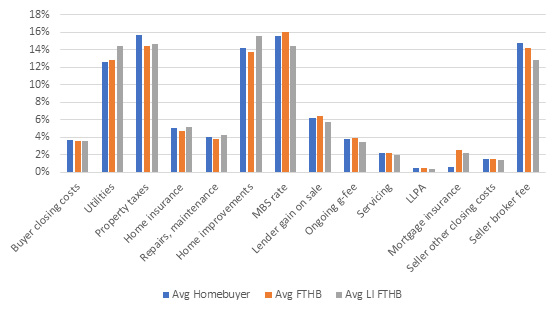What are the biggest costs of homeownership? (Hint: It’s not what you might think)
As any homeowner knows, the purchase price of a house is only one part of what it costs to own a home. From the very moment a home purchase is closed on, to the time that home is sold, a homeowner is subject to a sometimes-blinding array of costs, many of them hidden, unrecognized, or misunderstood.
In a recent Fannie Mae working paper, we sought to pull the curtain back on these costs. Our goal was to use the fullest possible array of mortgage and household expense data to build a comprehensive picture of costs to a homeowner, as well as what those costs are for and where that money goes.
Our key findings:
- The largest contributors to housing costs are consistently non-mortgage ongoing costs, which collectively are about half of total borrower costs over the ownership period. Indeed, the largest non-mortgage expenses for all borrowers are utilities, property taxes, and home improvement expenses.
- Transaction costs at purchase and sale comprise roughly 20 percent of total costs, with the broker fees at sale standing out as the largest such expense.
- The typical mortgage accounts for roughly 30 percent of total cost of housing over a typical seven-year homeownership cycle. Within those costs, the largest portion of those costs go to investors in mortgage-backed securities, while the second largest cost is typically the lender gain-on-sale, or GOS, which amounts to a one-time fee for the originator of the mortgage.
- Guaranty fees, inclusive of the loan-level price adjustments (LLPAs) charged by the government-sponsored enterprises (or GSEs, such as Fannie Mae and Freddie Mac), comprise approximately four percent of the total cost of homeownership. Private mortgage insurance is also a small component of costs, ranging from one to three percent of total costs.
Deconstructing housing costs for different borrowers
While each homeowner's total cost is different, of course, examining broad categories of homeowners and analyzing their costs, we believe, could provide insights into the drivers of housing affordability – or lack thereof. The mechanics of mortgage costs may be difficult to understand in their particulars, but how those costs translate into actual consumer costs, and how those costs compare with other elements of total housing costs, paints a far more useful picture.
To do this, we made a set of assumptions about a typical homeownership lifecycle (seven years) and plugged in what we know about housing and borrowing costs. A key advantage we had in this work was our access to internal Fannie Mae loan acquisition data, matched with internal closing costs data for 2020, which created a tailored view of costs for three different borrower profiles, each profile based upon single-family mortgages Fannie Mae acquired in 2020. Those profiles were:
- All home purchasers
- First-time homebuyers (FTHB)
- Low-income first-time homebuyers (LI FTHB)
Table 1 highlights some average basic borrower and loan characteristics in the data across our three borrower profiles. The table displays the average values for each of these populations and sub-populations. In general, the differences across borrowers are what you might expect: The average homebuyer is older, has a higher monthly income, lower loan-to-value ratio (LTV), and higher average home purchase price than both FTHBs and low-income FTHBs. In contrast, the low-income FTHB has less than half of the average monthly income and the smallest average purchase price across borrowers. (This and much more data and analysis can be found in the full working paper.)
Table 1: Average Characteristics of Each Category of Borrower 1
| All Homebuyers | First-Time Homebuyers | Low-Income First-Time Homebuyers | |
| Average monthly income | $9,377 | $7,453 | $4,161 |
| Average borrower age | 42 | 36 | 35 |
| Average purchase price | $318,281 | $291,139 | $222,243 |
| Average credit score | 754 | 746 | 747 |
| Average loan-to-value | 83% | 89% | 89% |
Source: Fannie Mae purchase acquisitions and closing cost data, 2020.
The categories of cost
Figure 1 reflects the overall framework for how we categorize housing costs over time. We set up our analyses to incorporate purchase costs, ongoing homeowner expenses over years one to seven, and sale costs in year seven.
Figure 1: Homeownership Costs During an Ownership Period
Understanding the underlying components of the three broad categories of costs in Figure 1 is essential to understanding the total costs picture.
Transaction Costs
We began with transaction costs, which are paid at purchase and sale. At purchase, closing (transaction) costs are not restricted to mortgage financing costs, but rather include all key transaction costs and fees, such as: loan origination fees, appraisals, credit reports, title reports, title insurance, settlement charges, local transaction taxes and recordation fees, and similar related costs. Using Fannie Mae closing cost data, we tailor our costs to each category of borrower at purchase. In assessing costs at sale, we project the sales price for each home using historic Federal Housing Finance Agency (FHFA) House Price Indices applied to the average purchase price, and then use the average sales costs as a share of sales price to calculate sales costs for each category of borrower.
General Housing Costs
Next, we estimated ongoing non-mortgage costs incurred by homeowners over the seven-year ownership period using detailed data on the main categories of homeowner expenses: utilities, property taxes, homeowner insurance, repairs and maintenance, and major improvements (capital expenditures), all derived from the American Housing Survey for 2019. To allow for variation across borrowers, we tie the average borrower expenses to the average purchase prices for each borrower profile.
Dissecting the Mortgage Payment
Then, we turn to mortgage payments, a critical piece of costs for borrowers. It's important to remember that while borrowers write one monthly check, the components of that payment can be complicated, and pieces of it go in different directions to different parties.
We used the Freddie Mac Primary Mortgage Market Survey (PMMS) of lenders to establish the average mortgage note rate for loans in 2020. For mortgages that are sold into the secondary mortgage market to a GSE, the note rate incorporates the yield required by mortgage-backed securities investors (MBS rate), a servicing fee of at least 25 basis points (capped at 50 as allowed by the GSEs), and the guaranty fees (g-fees). The g-fees cover the GSEs' cost of ensuring timely payment of principal and interest to investors and the ongoing administration of the MBS. The g-fees are in most cases split into a one-time upfront fee that is paid at the time of loan delivery (known as loan-level price adjustments or LLPAs) and a periodic fee. These different components of the note rate are reflected in the following equation:
Mortgage Note Rate = MBS Rate + Servicing Fee + GSE G-Fees + Lender Gain-on-Sale
The LLPA fees are publicly available and vary based on specific borrower credit risk. We matched the LLPAs to our three purchase borrower profiles to determine the appropriate values in our three examples (25 basis points for all profiles). LLPAs are paid as a share of the outstanding loan balance and are typically charged to lenders upfront, but lenders often convert them to an annual charge by dividing by the expected loan life and passing the cost of this fee, over time, to the borrower. Thus, for borrowers, the LLPA is typically folded into their monthly interest payments.
The upfront LLPAs have a wide range of values and can be as high as 375 basis points (then divided by the expected loan life and folded into the note rate) for a borrower with a credit score below 620 and LTV greater than 97 percent. However, due the many special mortgage products geared to lower income borrowers with low down payments, such as HomeReady®, Housing Finance Agency (HFA) loans, and Duty to Serve lending programs, coupled with the actual credit attributes of loans delivered to Fannie Mae, in practice many loans to low-income purchase borrowers in 2020 received LLPA rebates or credits. That is, many low-income borrowers don't ultimately pay for the LLPAs. The median LLPAs for low-income purchase borrowers in 2020 are shown in Table 2.
Table 2: Median LLPAs for Low-Income Purchase Borrowers 2
| LLPA for LTV <= 90% | LLPA for LTV > 90% | % of total Fannie Mae purchase volume | |
| LI, not FTHB, HomeReady, or HFA | 25 | 25 | 8% |
| LI FTHB, Not HomeReady, or HFA | 50 | 50 | 10% |
| LI FTHB, HomeReady | 0 | 0 | 7% |
| LI FTHB, HFA | -50 | -50 | 1% |
The ongoing (non-LLPA) g-fee is an annual payment charged as a percentage of the loan balance for the life of the loan, also passed to the borrower through the monthly interest payment. The ongoing g-fee varies by product type, but FHFA sets the ongoing g-fee floor for MBS transactions (as of 2021, it is approximately 44 basis points).
Finally, we estimated the lender gain-on-sale (GOS) when the loan is sold into the secondary market. The GOS comes from the remaining interest payment from the borrower after the MBS rate, servicing fee, and g-fees are covered. To calculate this borrower cost, we rely on the difference between a mortgage's interest rate and the coupon rate on the MBS pool into which it is sold (the primary-secondary spread). As described in more detail in our working paper, for our typical borrower, we calculate a GOS of 73 basis points of ongoing borrower payments is available to be capitalized into a one-time gain that goes to the lender when the loan is sold.
Translating the cost components into a total cost picture
We used a discounted cash flow model to establish the contribution of each housing expense to the overall housing costs for our three borrower profiles. We used a two percent discount rate, the Federal Reserve inflation target from the time period specific to these loans, to discount the cash flow streams back to the present. Finally, using these present values, we calculated the contribution of each type of housing expense to overall homeowner costs. These results are shown in Figure 2.
Figure 2: Breakdown of Borrower Costs by Borrower Profile
Source: Author calculations of the total lifetime costs of ownership for the average homebuyer, FTHB, and low-income FTHB purchase borrower in Fannie Mae's 2020 acquisitions and closing cost data.
The takeaway? Borrowing is a big piece of the cost of owning a home, but that cost often is overshadowed by utilities, property taxes, home repairs, and one-time fees paid to various parties to buy and sell a home.
Why did we do this analysis? Because housing affordability is and will continue to be a matter of profound concern to homeowners and those who wish to own a home. Understanding the total cost picture can not only provide consumers better information to make decisions, but it can also offer mortgage and housing industry participants, housing advocates, and policy makers better tools as they seek to find ways to drive down the cost of homeownership – particularly for those eager to become first-time homeowners.
By Jaclene Begley and Mark Palim
March 9, 2022
Opinions, analyses, estimates, forecasts and other views of Fannie Mae's Economic & Strategic Research (ESR) Group included in these materials should not be construed as indicating Fannie Mae's business prospects or expected results, are based on a number of assumptions, and are subject to change without notice. How this information affects Fannie Mae will depend on many factors. Although the ESR group bases its opinions, analyses, estimates, forecasts and other views on information it considers reliable, it does not guarantee that the information provided in these materials is accurate, current or suitable for any particular purpose. Changes in the assumptions or the information underlying these views, including assumptions about the duration and magnitude of shutdowns and social distancing, could produce materially different results. The analyses, opinions, estimates, forecasts and other views published by the ESR group represent the views of that group as of the date indicated and do not necessarily represent the views of Fannie Mae or its management.
1 We rely on averages, but there will be different distributions within the variables for specific borrowers. Using the average purchase price, LTV, closing costs, and mortgage amounts may not align to an actual unique borrower. Similarly, we rely on the average LTV for each group to calculate the mortgage insurance requirements and term.
2 For our main analyses, we show the down payment and principal repayment as separate contributions to wealth and not expenses. However, in our full working paper we also explore differential housing wealth accumulation across borrowers. Additionally, we include an analogous view of the breakdown of housing costs reflected in Figure 2 that incorporates principal payments treated as a borrower expense.




